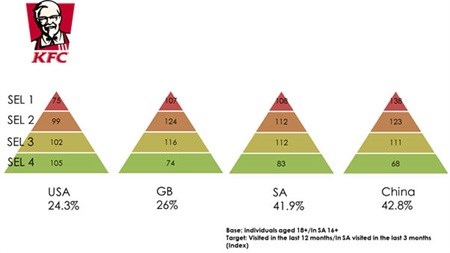New segmentation tool could vie for LSM place
SELs are a valuable insights tool for marketers, researchers and brand owners, providing an understanding of not only a consumer's potential to spend, but the social context in which this potential is held.

The selection and weighting of robust TGI samples is based on global best practice. The annual local sample size is 15,000 and global sample size is 800,000. SELs present a harmonised approach to socio-economic classification across multiple markets and works alongside national classification systems. Unlike most socio-economic grading, which use the household basis, the Global TGI SEL is based on individual spending power and SEL groups are based primarily on consumption variables.
The relevance of this is that not all members of a household fall into the same socio-economic class. Looking at socio-economics rather than economic levels in isolation provides the marketer with valuable information so that he or she can target the campaign to the desired consumer and talk to the person rather than just talking to the wallet.
Common reference points
The importance of local measures is rooted in providing marketers and researchers with a common reference point. Local measures are based on the local economic environment and respect national cultural concepts. These measures also take into account the evolution and marketability of certain categories and products within that environment.
The company has recently launched TGI Township in South Africa, as these communities are misunderstood to a large degree. Understanding and appreciating the nuances of township consumers will empower brands to tap into this market successfully. With TGI Global SEL, TGI users worldwide are given a unique and consistent way of directly comparing segments of the population.
The development of a global social economic classification system is not intended to replace or challenge the local definitions already in existence. Rather, the desire of global marketing and consumer insights teams to compare national social economic grades directly across countries has highlighted a significant need for the development of a standard global system. Along with the expansion of brands and media beyond the boundaries of individual countries, the need exists to make direct comparisons between the social economic status of brand users and potential users in different parts of the world.

Socio-demographics play large role in consumer behaviour
Developing countries rarely use income as a measure of spending power due to limitations related to collecting income data accurately. Even in countries where income is considered a reliable and accurate measure of spending power, the issue remains that it does not take into account social influences such as the person's or household's social position within the population, which is considered a key influence in consumer behaviour.
Socio-demographics play a large role in consumer behaviour. A Lottery winner is likely to have a different approach to spending than the person born into a wealthy family, or the person who built their own profitable business from scratch.
Difference between SELs & LSMs
1. LSMs have been developed as a tool to measure macro or gross changes in the living standards of a given population over time. They are calculated from the collective living standard of a household, and all members of that household will fall into the same LSM group.
2. TGI SELs are based on a score allocated to an individual and different individuals in the same household can fall into different SEL groups.
3. Once allocated to a designated LSM group, an individual's propensity to be a valuable consumer cannot be assessed. A young student, earning no income, but living in a household where the main earner has a substantial income, will be assumed to have the same value as a potential consumer as the head of the household.
4. With TGI SELs, the individual's potential to be a valuable consumer is reflected by the SEL group in which he or she is allocated.
In essence, LSMs and SELs measure different aspects, and they have different applications. LSM is a local measure based on a household level consumption and income. On the other hand, SEL provides a socio-economic view of the individual consumer which can be applied and compared globally.
SELs in action
Analysing a global brand, such as KFC, by SELs, allows for cross-country comparisons as well as an understanding of the local market. Analysis of TGI data shows that the social economic profile of KFC consumers are fairly flat in the US and slightly skewed to lower social economic individuals. In Great Britain and South Africa, the brand is positioned within the middle social economic groups. In China, the brand is skewed towards higher social economic profiles.

This highlights the differing profiles of a brand, in terms of consumer potential, across different markets. This is an important consideration when adopting strategies to communicate with these individuals, grow within a market or retarget the brand.
In summary, SEL groups are mainly based on consumption variables. It classifies individuals based on their consumer behaviour. It offers a harmonised approach to socio-economic classification across multiple markets and works alongside national classification systems.














